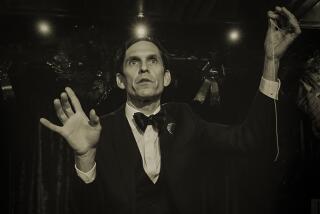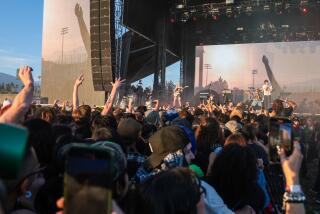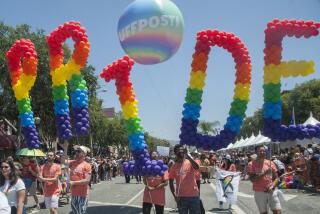Keeping it real at the Fake
YOU couldn’t make up a neighborhood like this: In the space of a few storefront doors, you can puff on a hookah at a Middle Eastern coffeehouse, savor a scoop of sunflower-seed ice cream from an experimental ice cream parlor, have the friendly folks at the socialist bicycle shop show you how to change a tire, or drop in at a marijuana clinic (for purely medicinal purposes, of course).
And if by chance you’re not invited to the quinceanera that’s rocking the house at the Ukrainian Culture Center next door, you might stop for a gander at the Fake Gallery, a tiny island of misfit comics and merry pranksters situated at the heart of this oddball block of Melrose Avenue, adjacent to Los Angeles City College and southwest of Silver Lake.
“I like to call it ‘Silverwood,’ ” says Paul Kozlowski, the quietly intense impresario and curator of the Fake, where an eclectic mix of comedy, music and performance coexists with a collection of original paintings and irreverent mixed-media works by such up-and-coming artists as William Hooply and Roy Biv.
Haven’t heard of them? The gallery’s name is a clue: Hooply and Biv are just two aliases of the polymathic Kozlowski. A comic who rode the stand-up boom of the 1980s and then, like many of his peers, migrated to writing for television (“The Jon Stewart Show,” “Mr. Show,” “The Wayne Brady Show”), Kozlowski first began making “stuff that looked like art” out of frustration with TV’s infamously stifling committee process.
“When I started writing for TV, I lived in New York, and I would come home and just start doing art,” says Kozlowski, a squat, restless man with a gray beard and a black mustache, who sits under a skylight and a small disco ball amid his irony-laden paintings and sculptures. Two cats loll on the stage in the afternoon heat. “Writing on TV was such a collaborative thing; everything had to be cleared and checked and redone. I needed to do something of my own that couldn’t be changed.”
When he moved to Los Angeles in the late 1990s, he discovered a network of similarly frustrated colleagues, successful in films or television to various degrees but craving an unfettered outlet.
“There’s a huge resource of performers who live here and they’re kind of miserable, because show business breaks you down,” Kozlowski, 42, says.
He already had an idea what the alternative might look like: In his formative years in Chicago, he had preferred the offbeat crowd at a seedy venue called Zany’s to the improv thoroughbreds of Second City, and in New York he gravitated to the Lower East Side’s underground comedy scene rather than to the tourist-heavy mainstream clubs.
Kozlowski first unleashed his brand of experimental comedy in L.A. with a weekly sketch show at the HBO Workspace. After that venue changed hands in 2001, he found an empty studio in a 1920s building on Melrose, which had previously served as a juice bar and a rave club, and turned it into a gallery and performance space. He couldn’t afford fancy decor, so he put his own artwork on the wall to “fool people that it was a happening place.”
More than window dressing, the art on the walls became the Fake’s meal ticket.
“I did a show for one night, and I sold pretty much everything,” Kozlowski said. “I made enough money to rent the space for a whole year. I was kind of embarrassed. I had tried really hard for the acting and comedy stuff, but the thing that I just do because I have to is the thing that really connected.”
Most of his paintings are in an accessible Pop art vein, with pleasant colors and jokey text, while his mixed-media work incorporates found objects, often also with text, like an old baseball imprinted with the words “lost home run” or a seat with barbed-wire upholstery labeled “Danger Chair.”
What the art sales make possible is a performance calendar that includes a regular Thursday stand-up night, “The Fake Show”; an ongoing “Fake Music” series on Saturdays featuring bands, typically with a comic bent; and a shifting roster of recurring formats. Among them: a slide-show evening, a two-minute sketch show, re-creations of old-time radio plays and occasional one-night stands by such comics as Maria Bamford and the aforementioned Mr. Hooply.
On a recent Thursday, “The Fake Show” attracted a medium-sized crowd of comedy geeks, ranging from young unknowns such as Rajan Desai and Andrew Lasken to such veterans as Bamford, Rick Overton and Steve Rosenfield. Each comic gets five minutes max -- a time limit that recalls the format of the open mike at Holy City Zoo, the legendary, now-defunct San Francisco venue where Kozlowski rubbed shoulders with the likes of Robin Williams and Bobcat Goldthwait. These two elder statesmen of comedy were on hand for last week’s “Fake Show,” though they didn’t perform.
“In some ways this is more wild than Holy City Zoo,” Williams said. Inspired by Lasken’s deadpan Stephen Hawking impression, Williams said he’s thinking of working up a bit involving “Freud as a ventriloquist.”
GOLDTHWAIT, puffing a cigar outside after the show, favorably compared the Fake with other “alternative comedy” venues in L.A., saying, “What’s different about the Fake is that it’s not bitter, it’s not snarky. It’s not kids dressed in American Apparel bitching about work they didn’t get.”
(Though he didn’t say as much, he could be describing an off night at Largo or M Bar.)
Rosenfield, a soft-spoken joke machine, agreed: “It’s a little more friendly here, less cynical and angry, than some clubs. Some of the people here have had success, but they’re not jaded.”
Frank Conniff, best known from his work on the TV series “Mystery Science Theater 3000,” co-hosts the show (with various others) from a balcony seat; his cherubic visage appears between sets on a downstage monitor.
“Venues like this have reinvigorated my career as a comedian,” Conniff said. “For me, the Fake is keeping the flame of alternative comedy alive.”
Overton, who closed last week’s show with a whimsical fantasy tale that lightly parodied fantasy writer J.R.R. Tolkien, said that the vibe at the Fake recalls the days before comedy became a victim of its own success and the airwaves were glutted with the form.
“The big clubs used to be like this,” Overton said. “They didn’t have the criteria to say, ‘That guy’s weird.’ They didn’t have enough guys.”
Performing in an art gallery -- even a “fake” gallery -- seems only fitting, Overton said. “I think it’s OK to call this art again.”
*
The Fake Gallery
Where: 4319 Melrose Ave., L.A.
When: “The Fake Show,” 8:30 p.m. Thursdays; “Fake Music,” 9 p.m. Saturdays. Gallery hours: noon- 4 p.m. Saturdays.
Price: “The Fake Show,” $10; “Fake Music,” $5
Info: (323) 661-0786; www.fakedotcom.com
More to Read
The biggest entertainment stories
Get our big stories about Hollywood, film, television, music, arts, culture and more right in your inbox as soon as they publish.
You may occasionally receive promotional content from the Los Angeles Times.










